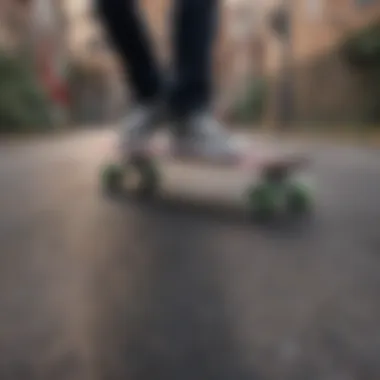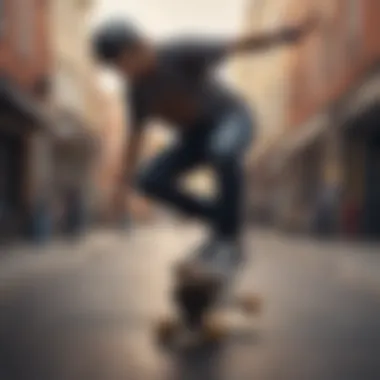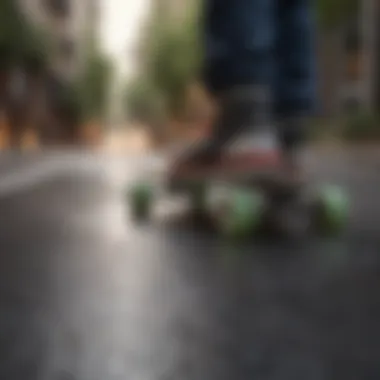The Drop Skateboards: An In-Depth Exploration


Intro
Drop skateboards, a variation that has gained significant traction in the world of extreme sports, deliver a distinct riding experience. Characterized by a lower deck that sits closer to the ground, these skateboards facilitate a more stable ride. This design is not just for aesthetics; it offers practical benefits in terms of balance and control. As enthusiasts and newcomers alike delve into the culture surrounding drop skateboards, understanding their intricacies becomes essential.
Techniques and Tips
Skating on a drop board requires specific skills. Mastering these can elevate the riding experience.
Skill Development
For those new to the sport, gradual skill development is crucial. Start by practicing basic movements and balance.
- Foot Placement: Position your feet correctly to help maintain control. The back foot should be on the tail while the front foot is near the middle.
- Body Position: Keep your body low to enhance stability.
Defining each motion contributes to an effective learning curve.
Practical Techniques
Executing fundamental techniques can significantly improve your performance. Techniques like carving, sliding, and pushing should be practiced regularly.
- Carving: Shift your weight smoothly while turning to experience the board's maneuverability.
- Sliding: With practice, sliding can become a thrilling element of riding. Start on smooth surfaces before moving to more complex environments.
Common Mistakes to Avoid
To ensure a safe experience, being aware of common pitfalls is vital.
- Overcompensating: Many riders tend to overcorrect while steering. This can lead to loss of balance.
- Neglecting Protective Gear: Not using safety equipment can result in injuries.
Gear and Equipment
Selecting the right gear significantly impacts your skateboarding journey.
Essential Gear for Beginners
Starting with the proper equipment is important for safety and performance. Essential gear includes:
- Helmet: A well-fitted helmet can prevent serious injuries.
- Pads: Knee and elbow pads provide additional protection.
Latest Innovations and Trends
The skateboarding industry is always evolving. New materials and technologies frequently enhance gear performance. Keep an eye on emerging brands and products that offer better durability and design.
Reviews and Comparisons
Before purchasing skateboards or equipment, it's beneficial to read reviews. Online communities, such as those on Reddit or dedicated skateboarding forums, often provide valuable insights on various products.
Safety Measures
Safety cannot be overlooked in extreme sports.
Essential Safety Gear
In addition to routine gear, consider:
- Protective Gloves: These help protect your hands during falls.
- Proper Footwear: Choose shoes designed for skateboarding, as they provide better grip and support.
Best Practices for Safe Participation
Planning your rides carefully contributes to safety:
- Choose Safe Locations: Opt for smooth, closed-off areas while practicing.
- Ride with Others: Having fellow skaters around enhances safety during practice.
Injury Prevention and Management
Understanding how to prevent injuries is crucial. Warm up before skating and listen to your body’s signals to avoid overexertion.
"A disciplined approach to safety and skill development creates an enjoyable riding experience."
Spotlights on Extreme Sports


Highlighting activities and athletes can inspire enthusiasts to engage deeply with the community.
Featured Sport of the Month
Every month, a different sport within the extreme sphere deserves attention. This month, longboarding gains focus due to its intersection with drop skateboarding, emphasizing flow and style.
Profiles of Prominent Athletes
Exploring the stories of influential skateboarders can serve as motivation. Notable figures bring innovation and creativity to the sport, transcending conventional boundaries with their skills.
Prologue to Drop Skateboards
Drop skateboards stand out in the world of extreme sports, merging innovative design with enhanced riding experiences. Understanding drop skateboards is essential for both beginners and seasoned riders. These boards offer unique features that enhance stability and control, making them appealing for various riding styles. Their evolution reflects not only advancements in material and technology but also changing preferences within the skateboarding community.
Definition and Overview
A drop skateboard is characterized by its unique design, where the deck is lowered between the wheels. This design feature lowers the rider's center of gravity, which subsequently increases stability and control, particularly during high-speed maneuvers. The boards are available in various sizes and shapes, catering to a broad range of riding styles including cruising, downhill, and freestyle. Significantly, drop skateboards often utilize materials like bamboo, maple, or composite materials, which can influence weight and flexibility.
The Evolution of Skateboarding
Skateboarding has undergone substantial transformation since its inception in the 1950s. Initially a simple combination of a board and wheels, the sport has diversified into multiple styles and designs over the decades. In the early years, typical skateboards were much shorter and offered limited stability. As riders pursued tricks and speed, the need for specialized designs emerged, leading to the development of designs such as the drop skateboard.
Today, drop skateboards are not merely tools for transportation or tricks. They represent a growing culture that encourages innovation while emphasizing riders’ safety. The advancements in skateboard technology, including improvements in wheel hardness and materials, have made drop skateboards more accessible and appealing.
Understanding the evolution of skateboard design aids in appreciating modern enhancements, especially for drop boards, making the exploration of this niche fascinating for enthusiasts.
Understanding Drop Skateboard Design
The design of drop skateboards is crucial to their performance and appeal in the realm of extreme sports. Understanding the nuances of this design allows riders to appreciate how different elements contribute to the overall experience. Each component plays a role that aligns with performance, comfort, and safety concerns. In this section, we will delve deeper into the key features of drop skateboards and conduct a comparative analysis with other designs to illustrate their uniqueness and advantages.
Key Features
Board Shape
The board shape of drop skateboards is specifically designed to lower the rider’s center of gravity. This characteristic provides better stability during rides. Riders can easily navigate turns and shifts in terrain with confidence. The common shapes are typically concave to provide foot grip, which enhances control during maneuvers. What sets the board shape apart is its adaptability for a range of riding styles, from cruising to downhill. However, its shape can limit the options for tricks compared to more traditional boards.
Wheel Placement
In drop skateboards, the wheel placement is a defining aspect. Wheels are often positioned in a dropped manner, allowing for a lower ride height. This setup increases stability, especially when turning at higher speeds. Additionally, the placement reduces the chances of wheel bite, which is when the wheels touch the board during sharp turns, causing a potential fall. While the unique wheel placements favor speed and fast commuting, they may sometimes feel less responsive to quick adjustments compared to other designs.
Material Composition
Material composition affects the performance and durability of drop skateboards. Most commonly, decks are made from layers of maple or bamboo, combining strength with flexibility. The choice of material influences both the ride quality and the weight of the skateboard. Maple provides a sturdy yet responsive ride, while bamboo is lighter, making it popular for commuters. However, bamboo might not be as durable in heavy-impact situations. Securely understanding the materials can help riders choose a board that fits their style and needs.
Comparative Analysis with Other Designs
Top-Mount vs. Drop-Through
The debate between top-mount and drop-through designs is central to skateboard discussions. Top-mount boards have the trucks mounted on top of the deck, providing a higher center of gravity. This results in a more agile ride, thus allowing riders to perform tricks with greater ease compared to drop-through boards. Conversely, drop-through boards offer a lower center of gravity and enhanced stability. Therefore, the choice between these designs can affect performance greatly, depending on the riding style. Drop-through boards excel for long-distance cruising, while top-mounts might appeal more to trick enthusiasts.
Length and Width Variations
Length and width variations are other critical considerations when choosing a drop skateboard. A longer board typically offers additional stability, which is ideal for downhill riding. Wider boards provide more surface area for the feet, enhancing grip and comfort. Conversely, shorter boards favor agility and quicker turns, ideal for urban environments. The dimensions influence not only how the board feels underfoot but also how it performs in various riding scenarios, leading to a significant impact on preferences among riders.
Overall, understanding these design elements helps riders make informed choices about their skateboards, maximizing their riding experience.
Benefits of Using Drop Skateboards
The utilization of drop skateboards has its own unique advantages that make them appealing to many riders. These benefits primarily stem from the design characteristics inherent to drop skateboards. Stability, comfort, and adaptability to different riding styles are key factors that enhance the overall experience for both beginners and experienced riders. Each of these aspects contributes not only to the enjoyment of the sport but also to the safety and performance of the skateboard.
Stability and Control
One of the most significant benefits of drop skateboards is their stability. The lowered center of gravity helps riders maintain balance, which is especially important when going downhill or navigating uneven surfaces. The drop-through design allows for better positioning of the rider's feet, lowering their center of gravity. This design significantly reduces the chances of losing control, particularly for those new to the sport.
In contrast to traditional skateboards, drop skateboards provide an improved sense of control. This is crucial when performing tricks or moving at high speeds. Riders can feel more confident in their movements, leading to a more enjoyable ride.
Comfort and Ride Quality
Comfort plays a vital role in the overall riding experience. Drop skateboards are designed with broader decks that offer ample foot space. This extra space allows riders to position their feet however they feel most comfortable, decreasing fatigue during longer rides. Durable materials used in construction absorb some vibrations, providing a smooth ride on various terrains.


When it comes to ride quality, drop skateboards excel at maintaining momentum. The design facilitates easy pushing, allowing riders to travel longer distances without expending significant energy. With enhanced comfort, riders can enjoy prolonged sessions without worrying about discomfort or strain.
Versatility for Different Riding Styles
Drop skateboards cater to a diverse range of riding styles, making them extremely versatile. Whether one prefers casual cruising, freestyle tricks, or exhilarating downhill riding, drop skateboards accommodate these preferences effectively.
Cruising
Cruising on a drop skateboard is remarkably enjoyable. The design allows for smooth pushes and effortless gliding. Many riders appreciate this aspect for leisurely rides through parks or neighborhoods. This stability encourages longer rides, making it a perfect choice for commuters. The broad deck characteristic of drop skateboards enhances comfort, allowing riders to shift their weight as needed during casual rides. Generally, cruising becomes a seamless experience without the constant need to push off the ground aggressively.
Freestyle
Freestyle riding adds a different flavor to drop skateboarding. With their stable design, riders can experiment with various tricks and movements. The low center of gravity allows for better control while spinning or flipping. This aspect makes drop skateboards a favorable choice for riders who want to hone their skills in creative ways. However, the inherent stability can also limit the extreme maneuvers that some flat-out skateboards might accommodate, which is a factor to consider when choosing this riding style.
Downhill
Downhill riding takes a toll on equipment and the rider’s confidence. Drop skateboards excel in this area due to their superior stability and control. Riders can experience high speeds with the assurance that their board will keep them grounded. The design helps in maintaining stability and balance, critical when maneuvering downhill. However, riders must still be cautious. Excellent braking systems and protective gear become essential when engaging in downhill rides. Therefore, while drop skateboards provide significant advantages, the thrill comes with its set of challenges.
"Drop skateboards not only enhance riding experiences but serve as a bridge to explore various styles and techniques while maintaining control."
Techniques and Riding Styles
In the realm of drop skateboarding, understanding various techniques and riding styles becomes critical for both novices and seasoned riders. These skills not only enhance the overall riding experience but also enable individuals to express their unique style on the board. Mastery over techniques directly influences a rider's stability, control, and versatility, making it essential to explore these aspects thoroughly.
Basic Riding Techniques
Basic riding techniques form the foundation of skateboarding. They include stances, pushing, and braking methods. Developing comfort with these foundational skills is crucial. A rider should learn to balance and maneuver. The simplest yet most effective technique is the regular stance. It allows a rider to push off in a comfortable position, providing a solid base.
In addition, learning how to brake efficiently prevents accidents. The two main methods are foot braking and sliding. Foot braking involves dragging one foot on the ground, and this is a common choice among beginners as it feels intuitive.
Advanced Maneuvers
Advanced maneuvers elevate riding from basic skills to athletic performance. They not only enhance speed and control but also add flair to the riding style. Riders often progress to mastering these skills as they gain confidence.
Sliding
Sliding is an advanced technique where the rider intentionally causes the board to lose traction. This helps in reducing speed sharply. One key characteristic of sliding is its reliance on both body weight and control over the board. It is a popular choice for many riders due to its effectiveness in downhill scenarios. Sliding features advantages like sharper turns and maneuverability in complex terrains. However, it requires practice to execute safely and efficiently. Learning to slide can provide riders with a sense of mastery and confidence.
Carving
Carving is another important maneuver that involves leaning into the turns. It contributes to maintaining speed while navigating curves. The key characteristic of carving is its fluidity. This makes it a beneficial technique for cruising and downhill rides. Carving allows for smooth transitions between turns, which is satisfying and effective for maintaining momentum. However, mastering this technique can take time and patience, emphasizing the rider's commitment.
Freestyle Tricks
Freestyle tricks bring creativity into drop skateboarding. They encompass a wide range of skills, from simple ollies to complex flips. The unique feature of freestyle tricks is their ability to showcase individual style. Freestyle tricks can be beneficial as they engage riders physically and mentally. However, they often carry risks; beginners may face challenges when learning these tricks. Proper technique is essential to avoid injuries, making this a critical aspect of advanced riding.
Overall, the development of techniques and riding styles is integral to becoming a competent rider. By mastering these skills, individuals open doors to a rewarding and exhilarating skateboarding experience.
Safety Considerations
In the realm of drop skateboarding, adhering to safety considerations is not just about compliance; it is a core necessity that enhances the experience. Safety gear and practices are crucial in minimizing risks associated with riding. By prioritizing safety, riders can enjoy the sport while protecting against potential injuries.
Protective Gear
Helmets
Helmets are indispensable in skateboard safety. They provide crucial head protection in case of falls or collisions. A good helmet is designed to absorb impact, reducing the severity of injuries. Notably, the hard outer shell and inner foam lining work together to dissipate forces, making them a beneficial choice for all riders.
A unique feature of many modern helmets is their adjustable fit system. This allows riders to customize the fit, ensuring the helmet stays in place during rides, which is vital for effective protection. Despite their advantages, helmets can be cumbersome for some riders. However, the safety benefits far outweigh any minor inconveniences.
Pads
Protective pads, including knee and elbow pads, play a significant role in safeguarding vulnerable joint areas. These pads are typically made from high-density foam with a tough exterior that can absorb shocks effectively. The key characteristic of pads is their ability to prevent cuts and bruises while minimizing joint stress.
The unique feature of pads is their lightweight design, allowing them to be worn comfortably for extended periods. While some might view them as unnecessary, the truth is that they greatly enhance rider confidence, making them a beneficial choice in skateboarding. However, pads should be chosen carefully to ensure they fit well and do not hinder movement.
Shoes
Footwear is another important safety consideration in drop skateboarding. Shoes designed for skating typically feature flat soles and grippy materials. This design ensures a secure connection between the rider's feet and the skateboard, enhancing control.


A standout characteristic of riding shoes is the reinforced toe and heel, which offers additional protection against abrasions and impacts. Investing in quality shoes is a smart choice as they significantly reduce the risk of slips and enhance overall riding performance. It is worth noting that certain shoes may lack sufficient support for prolonged rides, which is a disadvantage to consider.
Best Practices for Safe Riding
Adopting best practices is essential for safe riding. Some key points to remember include:
- Choose appropriate terrain: Know the area where you will ride and its condition.
- Inspect equipment: Regularly check the skateboard for any wear or damage.
- Stay alert: Be aware of surroundings and other riders.
- Practice in safe environments: Start in low-traffic areas to build confidence.
By integrating proper safety gear and adhering to best practices, riders can significantly enhance their experience while minimizing risks and injuries.
Safety is not just about gear; it is about being mindful and proactive in your riding habits.
Understanding the Community
Understanding the community surrounding drop skateboards is crucial for comprehending the broader context in which this sport exists. The skateboarding community is diverse, encompassing local groups and global networks that share a passion for skating. Recognizing the distinct cultural elements and social dynamics enriches both the experience and the skill development of riders.
Local and Global Skateboarding Cultures
Skateboarding cultures can vastly differ based on location. Locally, the influences of street art, music, and lifestyle manifest in unique ways. In some cities, skateboarding might be tied closely to artistic expression, while in others it may embody a competitive spirit. Globally, cultures weave various international traditions into skateboarding. For instance, in places like Barcelona, the relationship with urban infrastructure makes it a haven for street skating enthusiasts.
Connect with Other Riders
Online Communities
Online communities serve as significant platforms for drop skateboard enthusiasts. These platforms include forums, social media pages, and video-sharing sites. One key characteristic is their accessibility; riders from all over the world can share experiences, advice, and tutorials.
The interactivity of these communities enhances the learning curve for beginners and provides a space for seasoned riders to refine their skills. A unique feature of these online networks is the ability to connect with others who share similar interests, irrespective of geographic location. While many discussions focus on techniques or gear, these platforms also foster a sense of belonging and camaraderie among riders. However, the downside can be information overload, making it challenging to filter out useful advice from noise.
Local Meetups
Local meetups bring riders together in a physical space, often fostering deeper connections than online interactions. These gatherings encourage community bonding through shared experiences and collaborative learning. A notable characteristic is the direct interaction between participants, which allows for immediate feedback on skills and techniques.
One unique aspect of local meetups is the potential to discover new spots for riding, thus enhancing the experience. These meetups often create a vibrant and supportive environment, helping newcomers feel welcome. Nonetheless, they may also have limitations, such as scheduling conflicts or varying participation levels, which can impact their consistency.
Community plays a pivotal role in shaping the skateboarding experience. Connect with fellow riders, both online and in local environments, to deepen your understanding and enjoyment of the sport.
Engaging with the skateboarding community, whether through online platforms or local gatherings, offers opportunities for learning and growth. It also opens doors to shared experiences, enriching not just individual skills but also the culture of skateboarding as a whole.
Trends and Innovations in Drop Skateboarding
The realm of drop skateboarding continually evolves, with trends and innovations playing a vital role in shaping the sport. Understanding these movements is crucial for enthusiasts and newcomers who wish to stay informed about the latest developments. Advanced technologies, new materials, and innovative designs all contribute to better performance and enhance the rider's experience. These progressions not only attract new participants but also keep seasoned riders engaged and excited.
Technological Advancements
The integration of technology into skateboarding has transformed how riders interact with their boards. One notable advancement is the use of high-performance materials. For example, carbon fiber is becoming a popular choice because of its light weight and durability. This material helps reduce the overall weight of the board while maintaining strength.
Another significant innovation is the refinement of manufacturing processes. Computer Numerical Control (CNC) machines allow for precise shaping that enhances control and stability. Riders can feel the difference when pushing their limits because these boards offer greater responsiveness. Additionally, some brands have started to include integrated features like Bluetooth speakers and LED lights, further enhancing the riding experience.
These advancements encourage riders to explore different terrains and speed limits. Perhaps most importantly, they keep safety a priority. Enhanced design features often lead to better shock absorption, decreasing risks of injuries when riding on rough surfaces.
Emerging Brands and Products
With the rise of innovative technology, several brands are forging a new path in the drop skateboard market. For instance, brands like Boosted and Evolve Skateboards have gained attention for their commitment to electric and hybrid models. Evolved features allow riders to navigate various terrains effortlessly, blending traditional skateboarding feel with modern technology.
Aside from established brands, several startups are introducing unique offerings. Companies like Arbor Skateboards focus explicitly on environmentally-friendly materials. Their products often emphasize sustainability while maintaining performance.
Many of these brands also focus on personalization. Custom paint jobs and design options allow users to express individuality, making the sport not only about performance but also about personal expression.
"Innovation in drop skateboards is not just about better materials, but also about understanding the rider's needs in a dynamic environment."
In summary, the trends and innovations in drop skateboarding reflect a continuous drive towards improvement. As this sport evolves, both technology and new brands play a crucial role in enhancing rider satisfaction and engagement. Keeping up with these developments is essential for anyone serious about skateboarding.
End
The realm of drop skateboards provides a unique blend of technique, culture, and innovation in the sport of skateboarding. Understanding the significance of drop skateboards touches upon several critical aspects, including their design features, potential benefits to riders, and the safety measures necessary for an enjoyable experience.
Final Thoughts on Drop Skateboards
Drop skateboards are not merely tools for transportation or recreation; they represent an evolution in the skateboarding community. Their distinctive shape and construction yield several advantages, such as enhanced stability and improved control. This stability is particularly beneficial for those tackling downhill rides or executing advanced maneuvers. Furthermore, the comfort and ride quality offered by drop skateboards elevate the experience for users, allowing for longer rides without significant fatigue.
Safety should also be highlighted in discussions about drop skateboards. Personal protective equipment like helmets and pads is essential, given the speeds that these boards can reach. Broadly, riders should adopt best practices to minimize risk while maximizing enjoyment, regardless if they are experienced or just beginning.
The cultural significance of drop skateboards is profound. They serve as both a means of expression and a tool for social connection among riders. Engaging with local communities or expanding into global networks fosters camaraderie and knowledge-sharing, enriching the overall skateboarding culture.
As the sport continues to evolve, innovations in drop skateboard design promise to enhance user experience even further. Emerging brands actively contribute to this growth, bringing fresh ideas that cater to diverse riding styles and preferences. This reflects the forward momentum of the sport and its community, inviting both old and new riders to explore what drop skateboarding has to offer.







